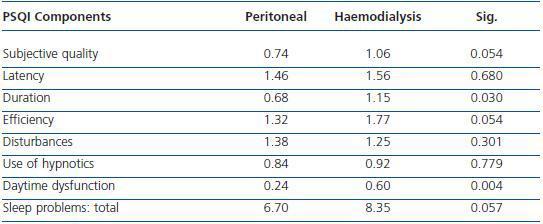Dear Editor,
The prevalence of sleep disorders in the general public varies between 10 and 40%;1 this figure increases to 50% in dialysis patients.2,3 There are very few studies comparing sleep quality according to the type of renal replacement therapy, which differ dramatically in terms of lifestyle.
In our study, we compare sleep quality between patients undergoing Peritoneal Dialysis (PD) and those undergoing Haemodialysis (HD), with samples of 49 patients similar in age, comorbidity index and time in dialysis.
The Pittsburg Sleep Quality Index (PSQI) was used. This consists of 24 items grouped into seven components: subjective sleep quality, latency, duration, efficiency, disturbances and daytime dysfunction. The higher the score, the lower the sleep quality.4,5
PD was generally performed according to a daily routine (95% of patients underwent automatic PD.) In the group of patients undergoing HD, 49% underwent HD in the first shift (08.00-12.00) and 51% in the second (14.00-18.00.)
Atotal of 73% of HD patients presented with sleep quality problems compared to 55% of PD patients. The majority of the problems were slight to moderate.
No relationship was found between sleep quality and the Charlson Comorbidity Index. However, in the overall sample, women presented with poorer sleep quality. Table 1 shows the affected sleep areas according to the type of therapy.
The only component with a higher score in PD was that of disturbances. This group of patients had a greater hourly routine than HD patients. In addition, HD patients who underwent treatment in the first shift presented a lower score.
Sleep quality is an important and determining factor in the quality of life during dialysis. The significant differences between both groups are consistent with the lifestyle associated with each technique.
The PSQI survey is a simple tool offering very complete information on sleep quality. The implementation of actions aimed at improving the hygiene of sleep may be an excellent way to improve the patients’ quality of life in an efficient and effective manner.
Table 1.








